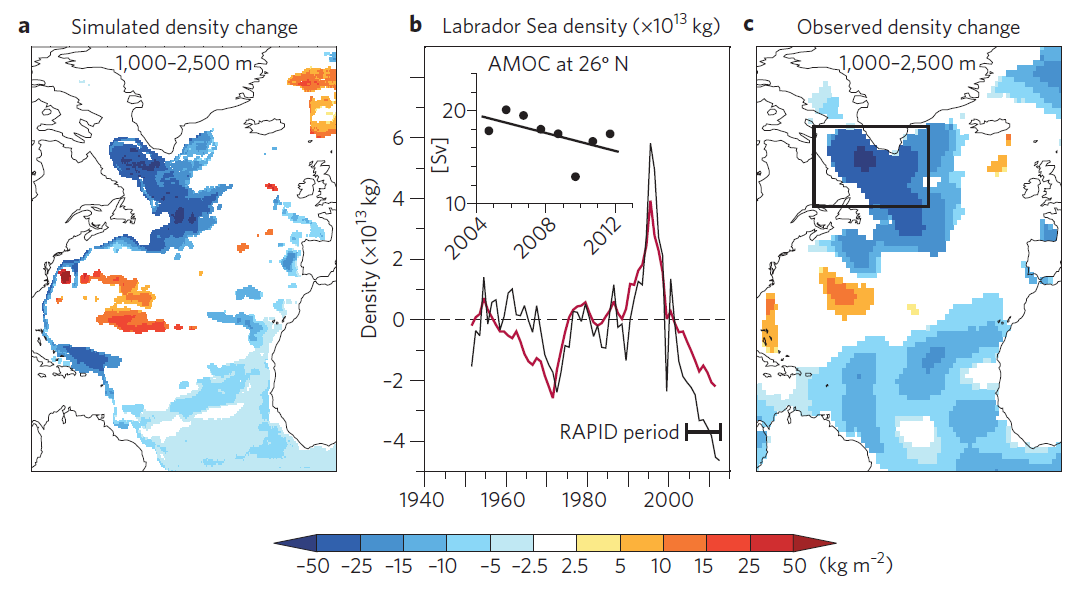Recent direct observations of the strength of the Atlantic Meridional Overturning Circulation (AMOC) show a decline of 10-15% since 2004. Is this a temporary fluctuation or part of a longer-term decline? A new analysis suggests that we might expect a further decline in the AMOC over the coming decade, which could impact on the climate of Europe and beyond.
The strength of the AMOC is thought to be an important regulator of North Atlantic sea surface temperatures. In particular, the AMOC has been linked to the Atlantic Multi-decadal Oscillation (see this previous post if you are interested in what drives the AMO), which has been shown to have an array of climate impacts, including on Northern Europe’s recent tendency for wash-out summers. In the models, when the AMOC is strong more heat is transported into the North Atlantic, which tends to make it warm compared to rest of the globe. But, when the AMOC is weak, the opposite is true.
However, the evidence that the AMOC is involved with these changes in surface temperature is essentially from indirect sources. This is largely because we have lacked the direct observations from which to measure the strength of the AMOC. However, since 2004 the joint UK-US RAPID array has been measuring the strength of the Overturning at 26°N. Interestingly, over the 8 years since the array was placed in the water it has measured a statistically significant decline in the strength of the overturning, of the order of –0.5Sv/yr (note: 1Sv = 1 Sverdrup = 106 m3/s). As Smeed et al. point out, such a decline is larger than might be expected from anthropogenic forcing alone, which might suggest that the current trend is largely due to natural variability. However, the record is also very short. Given that there are many drivers of AMOC change, including short-term wind changes, it begs the question, is this only a short-term temporary change, or is this part of a larger, more persistent event?
To answer this question we have to put the RAPID observations in a wider context. One relationship that holds true across most climate and ocean models is that density anomalies in the North Atlantic tend to lead changes in the strength of the AMOC. In particular, the density of deep sea water in the Labrador Sea is thought to be an important predictor of the AMOC (Fig. 1a, for the high resolution HiGEM model).
In the real-world, the historical observations of density in the Labrador Sea show some remarkable changes (Fig. 1b). In the early/mid-1990s the density of the deep water peaked, which many have previously associated with an increase in the AMOC, and a return to a positive AMO. However, since then there has been a dramatic decrease in the density in this region, to the extent that one data set suggests that density is now at a historical low. The pattern of observed density change in the deep North Atlantic (Fig. 1c) is also very similar to the pattern of density anomalies seen before a decrease in the AMOC in models (compare Fig. 1a and 1c).
Using this wider context suggests that the current observed decrease in the AMOC as observed by the RAPID array is not just a temporary blip, but is instead part of a longer term adjustment. Simple calculations suggest that the AMOC could have already reduced by 5-6Sv, a decrease of 20% or more. The observations also show no sign that the fall in Labrador Sea density has stopped. Therefore, a further decrease in the strength of the AMOC should be expected. Given the current understanding of the role of the AMOC in climate models, these changes suggest that we might expect the North Atlantic to cool or, at least, warm at a slower rate over the next few decades. Hence over the next few decades we could expect fewer hurricanes, more droughts in regions of North Africa, and maybe drier summers in Northern Europe.
It is worth saying that there is no evidence that this is a ‘Day after Tomorrow’ type collapse of the AMOC. But, there is still a great deal we do not know about the AMOC, including the relationship between the AMOC at subpolar and subtropical latitudes, or even to what extent it does significantly drive changes in Atlantic surface temperature. It’s also not clear to what extent, if at all, human induced warming is playing a role in the observed changes in the deep North Atlantic. Thus, these large ongoing events in the North Atlantic are an enormously important opportunity to understand and test the theories and models of AMOC dynamics. Importantly, we may soon have a much better idea of the AMOC’s role in climate.

This post is based on the study by Robson et al., 2014; Atlantic overturning in decline?, Nature Geoscience
It also seems to make a big difference on the teleconnections to NW Europe whether the decrease is a fluctuation or a trend, with trends having a large impact but fluctuations barely registering over land, neither in the observations nor in the ECHAM5/MPI-OM climate model (see Fig.3 in van Oldenborgh et al, OS, 2009).
Hi Geert Jan,
Yes, the NW Europe signal is certainly on the more tentative side. But it does look like there are seasonal variations in the response to the AMO, in Obs i.e. Sutton and Dong, 2012, in Nature Geoscience, but also even a hint in HadCM3 (http://journals.ametsoc.org/doi/abs/10.1175/JCLI-D-12-00827.1 – but note this study is using initalized predictions with HadCM3). Obviously, the signals a still noisey, and there could be a lot of influence from other things, i.e. the recent Arctic sea ice anomalies also, which could be completely unrelated to the AMO, or not. I’ll certainly not deny that there is a lot of work to do here to make sure the signal is robust.
Jon